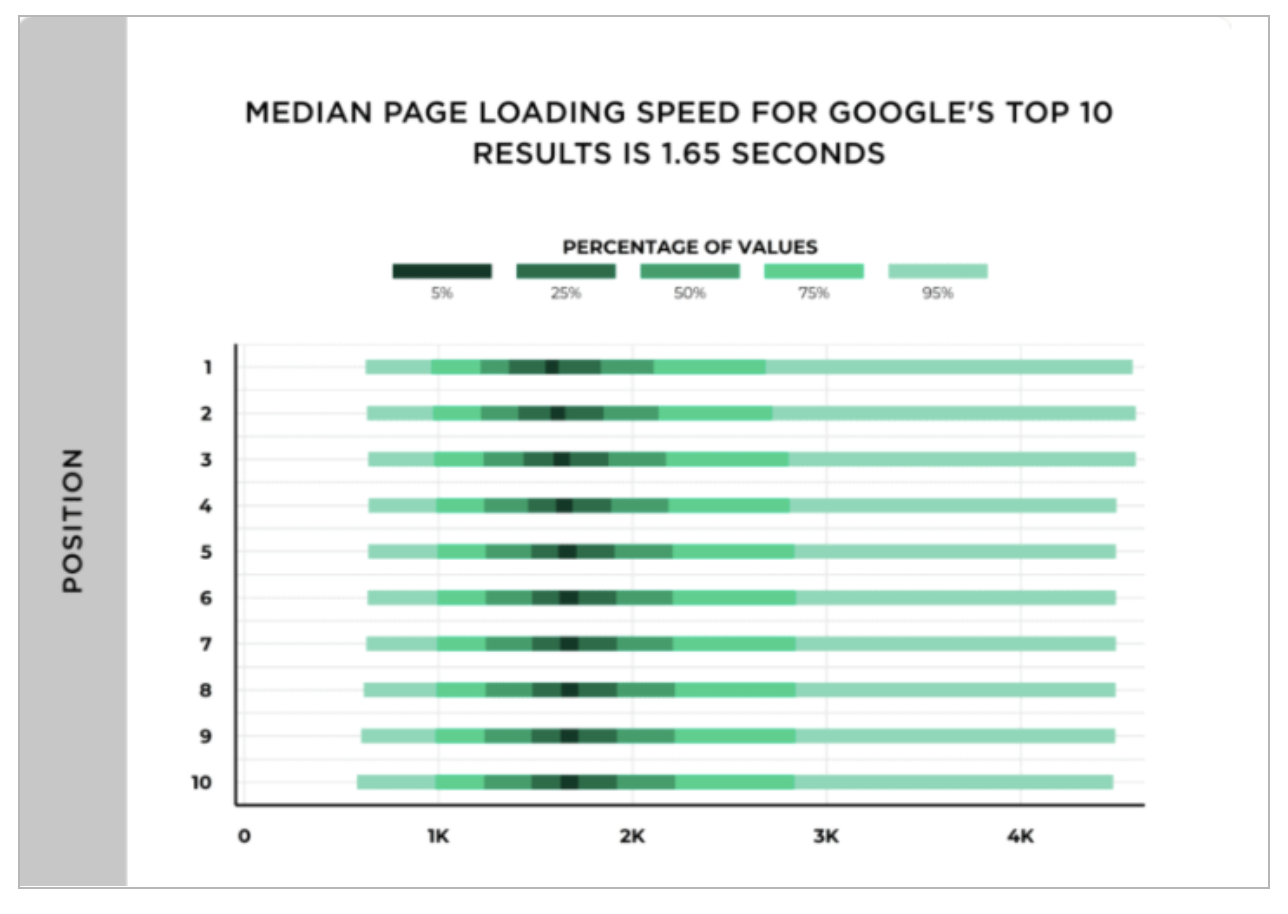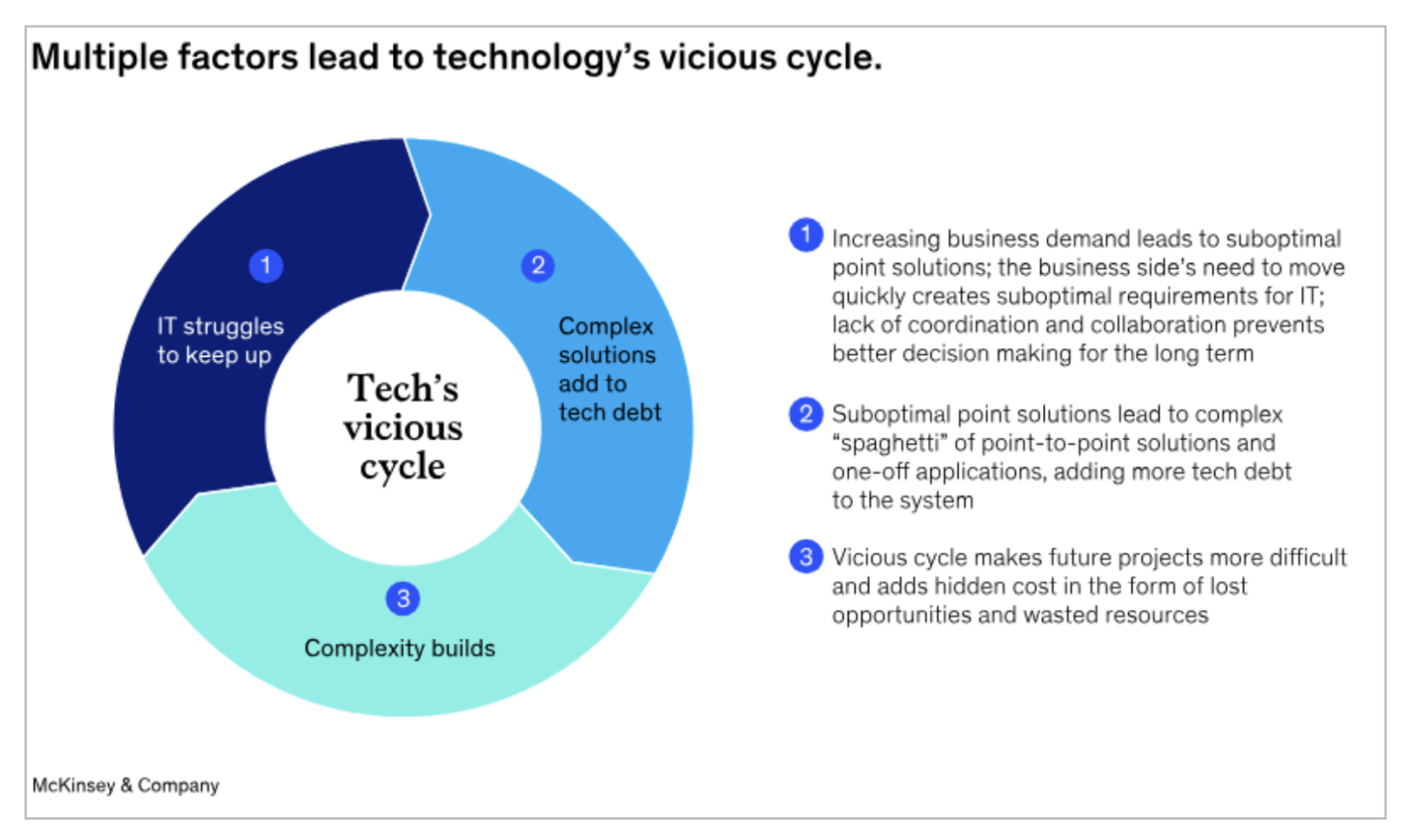Your product’s growing fast. You’ve got new users every week and the team is sprinting to keep up. Then one day, bam! Load times spike, features start breaking, bug reports flood in and everything feels like it’s on fire.
That’s technical debt and in web architecture, it builds up quickly and bites hard.
In this article, we’ll explore how technical debt drags down key growth metrics like revenue and retention, developer velocity and roadmap, and performance and SEO.
I will also share some strategies you can implement to reduce and prevent technical debt.
What is technical debt in web architecture?
Technical debt occurs when teams take shortcuts in code, IT infrastructure, or architecture to expedite development. Ward Cunningham coined the term, comparing it to financial debt: You borrow speed now, but repay it later with interest.
Just as financial debt can constrain a startup’s cash flow, technical debt can restrict a company’s ability to scale, adapt, and innovate.
In web architecture, debt shows up in a few ways:
- Infrastructure debt: You’re still using outdated servers or unsupported frameworks. Maybe you’ve skipped upgrades because migration sounds painful. That choice might save time now, but it slows everything down later.
- Front-end debt: This includes oversized image files, bloated JavaScript bundles, and no content delivery network (CDN). This is how you build debt, as users sit waiting for pages to load.
- Dependency debt: Using old plugins, third-party scripts, or libraries with known vulnerabilities. They might work for now, but you’re taking a risk on future compatibility and security. Regularly checking a vulnerability database can help you stay ahead of risks tied to outdated or unsupported components.
With technical debt, shortcuts add up and every patch makes your product harder to maintain.
How technical debt accumulates over time
According to a McKinsey study, technical debt represents approximately 40% of IT balance sheets. Furthermore, companies incur an additional 10–20% in costs to resolve technical debt, on top of existing project expenses.
This often leads to a vicious cycle where immediate fixes take precedence over strategic development, resulting in a lot of effort spent on staying afloat.
These quick fixes manifest in common patterns such as:
- Feature creep: Stakeholders want “just one more thing.” However, you’re still using the original codebase, so you add impactful features wherever they fit. Over time, your architecture looks like duct tape and dreams.
- Team turnover: Engineers leave, new team members join and documentation debt is outdated or nonexistent. Now, the team spends hours reverse-engineering decisions instead of building.
- Lack of long-term planning: There’s no architectural vision or a clear roadmap which results in everything being reactive. It’s easier to patch than to plan, so architecture debt keeps piling up.
- MVP rush: You rapidly deploy a minimum viable product. This often involves hardcoding elements, neglecting tests, and possibly utilizing tools known to lack scalability. It works, for now.
- Delaying infrastructure upgrades: You launch on shared hosting, which is fine for a landing page, but as traffic grows, it breaks down. Putting off the switch to VPS hosting leads to messy workarounds and every new feature gets harder to build.
The impact on performance and SEO
Even small bits of technical debt can ripple through your site’s user experience and rankings. What seems like a harmless workaround today can become a silent conversion killer tomorrow. This can lead to a myriad of problems.
Slower page load times
Users expect your content to load quickly; under three seconds. What happens if your site lags? They bounce, especially on mobile devices. Google tracks this behavior and bakes it into ranking decisions. (See the graphic below to see what I mean.)
Digital marketing strategist Neil Patel recommends that pages should load between one to two seconds, max.
To make sure your pages are loading at optimal speeds, you should be aware of what could be slowing them down.
The first one to keep in mind is no caching or lazy loading. Every user receives a fresh download of assets on every visit, with no service workers, CDNs, or browser cache leverage. Even large images and videos can harm your page speed, which is why it’s so important to compress your visuals. These should be ~200 KB to 5 MB in size. Even lazy loading can’t save you if the media isn’t optimized.
Also, don’t forget about bulky JavaScript and CSS bundles. Legacy frameworks, unused code, or inline styles often load sitewide, even when it is not needed.
The compound impact adds up. One of my e-commerce clients reduced homepage load time by 60% by compressing images, splitting JS bundles, and lazy-loading below-the-fold content. Their bounce rate dropped 18% and the average order value increased because users browsed deeper.
Crawlability and indexation issues
Search engines rely on a clean crawl path; unfortunately, a readable architecture and technical debt impacts both.
One of the issues that may cause crawlability and indexation issues is when you have duplicate content. This can be caused by improper management of parameters, copy-pasted templates, or poorly implemented localization.
Missing meta tags or XML sitemaps can also lead to technical debt. Google can’t rank what it can’t parse or find, so if you have broken internal links, make sure to fix them right away.
Worse still, technical debt often results in poor URL structure and buried content. I’ve seen SaaS platforms where critical onboarding or pricing pages were five levels deep with no contextual links. Googlebot crawled the homepage, hit a wall, and bailed. Those pages had traffic potential, but remained invisible.
Once the team restructured navigation and surfaced those pages, organic traffic grew 40% over the next quarter.
Mobile and Core Web Vitals penalties
When we are talking about technical debt, it’s safe to say mobile users get hit the hardest. Older CSS frameworks often weren’t built with mobile-first principles. On mobile devices, this translates to fonts scaling poorly, tap targets being too tight, and above-the-fold content taking forever to load.
Google’s Core Web Vitals Largest Contentful Paint (LCP), First Input Delay (FID), and Cumulative Layout Shift (CLS) are the official performance metrics that directly influence search rankings. In addition, Time to Interactive (TTI), while not a Core Web Vital, is a crucial user‑experience benchmark: it measures how long it takes for a page to become fully responsive to user input after it starts loading.
High LCP, FID, or CLS scores (or a long TTI) can all signal underlying technical debt. Falling short on any of these metrics can push your pages down in mobile search results.
The impact on developers velocity and product roadmaps
Technical debt slows developer teams from the inside out. It can result in the loss of time, predictability, and confidence, all before customers notice.
Increased bug rates and maintenance overheads
When code is messy or undocumented, even a single change can trigger three new bugs. Fixing one can break another and developers end up spending more time understanding the codebase than improving it.
In one of my client cases, a fintech startup’s legacy system caused daily hotfixes. Engineers were so busy firefighting that they had to delay the launch of a new feature by three sprints. That’s six weeks of lost roadmap time I saw firsthand…and it wasn’t pretty.
Slower feature releases
Feature releases should be predictable; however, when an organization accumulates technical debt, the process of delivering new features becomes anything but. Debt bottlenecks can appear in several critical areas and can impede development velocity and product growth.
- Lack of test coverage: Developers will sometimes test manually, or worse, skip testing altogether. As a result, QA cycles take longer or rollouts become risky.
- Outdated dependencies: Upgrading a package means rewriting half the app. If there is a delay, the upgraded information gap gets worse.
- Coupled components: Changing one module forces regression testing across others.
In fast-moving markets, speed wins. If it takes your team three weeks to release a feature your competitor shipped last quarter, you’re potentially losing market share.
One client trying to add a “save for later” cart feature had to untangle three jQuery versions and a homemade state management system. It took them five weeks while their competitor shipped it in five days.
Opportunity cost of product innovation
Every hour spent fixing brittle code is an hour not spent shipping experiments, launching betas, or improving onboarding.
Teams with clean, modern stacks can iterate based on usage data, launch integrations quickly, and run daily A/B tests.
Teams buried in debt are more likely to hesitate. Every change feels risky and innovation stalls.
I’ve seen startups with brilliant product ideas delay launches by quarters because they had to replatform first. That’s a business opportunity handed to someone else.
The impact on growth metrics
Technical debt quietly drains revenue. When pages load slower, search rankings slip, and conversions drop (especially on mobile). The lag between click and response costs you sales.
But the impact doesn’t stop at revenue. When features don’t work as expected, users bounce and many never come back. No amount of copy tweaking or A/B testing can out-optimize a broken experience.
That poor experience quickly turns into frustration. When things break, users don’t wait; they either reach out for help or churn.
It is often easy to spot technical debt across your website. For example, there may be feature inconsistencies across pages or devices, or buttons that only work in certain browsers. Forms that don’t submit properly could also indicate a technical issue. Each issue generates friction and that friction quickly turns into support volume.
This doesn’t just affect your users. Fixing technical debt lowers ticket count and frees up your support and engineering teams to focus on proactive improvements instead of firefighting.
The consequences also extend to your reputation. User expectations are shaped by the best product experiences in the world. If your site crashes mid-checkout or throws a 500 error during onboarding, it doesn’t matter how good your product is, trust erodes.
And brand trust matters in high-visibility moments.Think about investor demos, press mentions, or high-stakes partner pitches. One bad load can cost you a deal.
These examples aren’t just anecdotal. G2, Trustpilot, and app store reviews often cite “slow,” “buggy,” or “doesn’t work on mobile” as reasons for low ratings. Your tech stack quite literally affects your reputation.
Strategies to reduce and prevent technical debt
You can’t control everything during your build, but there are still tactics you can use to reduce and prevent some technical debt. I recommend the following tactics.
Use automated tests
Without reliable tests, every new feature is a gamble.
Start small:
- Build end-to-end tests for revenue-critical paths (checkout, signup, dashboards)
- Use snapshot testing for UI components
- Add unit tests for key business logic
Automated testing catches bugs and gives developers the confidence to ship faster without breaking things.
Ensure your team is aware that you’re transitioning from a “test later” approach to a TDD (test-driven development) model for core services.
Run regular SEO and performance audits
You can’t fix what you don’t see. Monthly technical SEO audits help identify creeping debt before it becomes a significant issue.
Use tools like Oncrawl to scan for:
- Pages failing Core Web Vitals
- Resource-heavy scripts
- Dead-end links
- Crawl traps
Go beyond static crawls too. Oncrawl’s log analyzer helps you understand how Googlebot and users actually move through your site to help make prioritization clearer.
Pro-Tip: Tie audits into your CI/CD pipeline to catch regressions immediately after deploys.
Move toward modular architecture
Legacy monoliths make every change riskier and more expensive. Refactoring doesn’t mean rebuilding from scratch, but it does mean starting to split key services.
Focus first on high-value areas that slow down the most releases, like payment processing, authentication flows, and CMS blocks.
Adopting a modular approach with APIs, containers, or a headless CMS creates separation of concerns. This helps your team conduct updates, rollbacks, and experiments faster and safer.
Use prioritization frameworks
Technical debt is overwhelming when everything feels urgent. A prioritization framework keeps things actionable when you’re unsure what to work on next.
Create a debt register with each item scored on:
- Impact (Does it affect customers or revenue?)
- Risk (What happens if it breaks again?)
- Developer effort (How many dev hours?)
Sort by high impact, low effort, then fix those first. Share this framework with stakeholders so debt discussions are backed by data.
Pro tip: Tag technical debt tickets clearly in your issue tracker. Over time, you’ll see where the patterns are.
Foster a debt-aware culture
You can’t fix what people hide. And most engineers know where the skeletons are.
Make tech debt part of sprint planning. Don’t treat it as after-hours work or something you’ll “get to later.”
Add lightweight policies like:
- No major release without test coverage and audit pass
- Every feature ships with a cleanup budget
- Leave code cleaner than you found it
Adding even a 10% “engineering health” buffer to sprints gives teams space to tackle tech debt without needing executive approval every time.
Closing thoughts
Technical debt in web architecture slows down your code. But it also hits your traffic, your team, and your top-line growth. It’s similar to financial debt, as it can affect your entire business model. You can’t avoid all debt. However, you can track it, manage it, and chip away at it without pausing progress.
My best advice is to start with visibility. Oncrawl’s SEO crawler and log analyzer can help uncover hidden debt. Then build a strategy to fix what matters most.
Pay it off early before it costs you customers.



